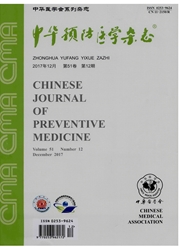

 中文摘要:
中文摘要:
目的以碘缺乏纠正状况和住院甲状腺疾病谱的变化对全民食盐加碘有关影响作出评估。方法对人群作碘营养状况与甲状腺肿调查,甲状腺疾病住院病历采用回顾性研究方法搜集。结果居民合格碘盐食用率达95%以上。社区居民甲状腺疾病年住院率暂时性上升最高达54.5/10万,住院甲状腺疾病占总疾病比重亦呈暂时性上升,女性和≥40岁组是受影响的主要人群,甲状腺功能亢进症占甲状腺疾病的比例由平均13.6%增加到34.7%。结论全民食盐加碘消除碘缺乏病的同时其他影响客观存在,碘缺乏的纠正所产生的效益远远超过其他影响的损失。
 英文摘要:
英文摘要:
Objective To evaluate the impact of universal salt iodization using monitoring data on correctional status of iodine deficiency and hospitalized thyroid diseases. Methods Retrospective survey was conducted to collect medical records of hospitalized thyroid disease cases. Routine monitoring data on population iodine nutrition status and goiter prevalence were analyzed. Results The coverage of adequately iodized salt was consistently above 95%. Hospitalization rate of thyroid diseases rose steadily, and peaked at 54. 5 per 100 000. The proportion of hospitalized thyroid disease among hospitalized diseases also rose with female and those aged above 40 years old mostly affected. The proportion of hospitalized hyperthyroidism among total hospitalized thyroid disease rose from 13.6% to 34. 7%. Conclusion Universal salt iodization might eliminate iodine deficiency while other impact still exists. However, the benefits of universal salt iodization should be far overweight the adverse effects.
 同期刊论文项目
同期刊论文项目
 同项目期刊论文
同项目期刊论文
 期刊信息
期刊信息
